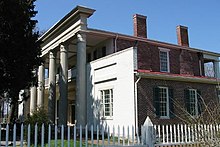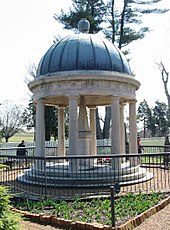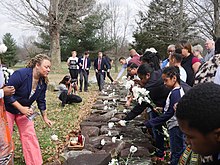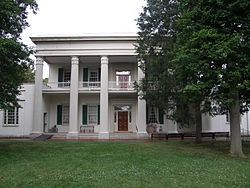|
The Hermitage (Nashville, Tennessee)
The Hermitage is a historical museum located in Davidson County, Tennessee, United States, 10 miles (16 km) east of downtown Nashville in the neighborhood of Hermitage. The 1,000-acre (400 ha)+ site was owned by President Andrew Jackson, the seventh president of the United States, from 1804 until his death at the Hermitage in 1845. It also serves as his final resting place.[3] Jackson lived at the property intermittently until he retired from public life in 1837. The Hermitage enslaved men, women, and children, numbering nine at the plantation's purchase in 1804[4] and 110 at Jackson's death,[5] worked at the Hermitage and were principally involved in growing cotton, its major cash crop. It is a National Historic Landmark. Mansion and groundsArchitecture  The Hermitage is built in a secluded meadow that was chosen as a house site by Rachel Jackson, wife of Andrew Jackson. From 1804 to 1821, Jackson and his wife lived in a log cabin. Together, the complex formed the First Hermitage, with the structures known as the West, East, and Southeast cabins.[6] Jackson commissioned construction of a more refined house, and the original mansion was a two-story, Federal-style building built with bricks manufactured onsite by skilled people. Construction took place between 1819 and 1821. The house had four rooms on the ground floor and four rooms on the second level, each with a fireplace and chimney. The large central hallways opened in warm weather from front to back to form a breezeway. A simple portico was added later. In 1831, while Jackson was residing in the White House, he had the mansion remodeled under the direction of architect David Morrison. The new structure included flanking one-story wings, a one-story entrance portico with 10 columns, and a small rear portico that gave the house a Classical appearance. In 1834, a chimney fire seriously damaged the house, with the exception of the dining room wing. This led to Jackson having the current 13-room, Greek Revival structure built on the same foundation as the former house. It was completed two years later. The architects for the house were Joseph Reiff and William C. Hume, who also built Tulip Grove across the road. The mansion has a rectangular layout, about 104 feet (32 m) from east to west and 54 feet (16 m) from north to south. The south front is the location of the main entrance and includes a central block with a five-bay, two-story structure with a portico supported by six modified Corinthian style, wooden columns with a simple entablature resting on the capitals. Within the portico is a second-story balcony with simple square balusters. One-story wings with single fenestrations flank the mansion and extend beyond it to the front of the portico, enclosing it on three sides. While the southern façade gives the appearance of a flat roof, the three other elevations show that the tin-covered roof is pitched. The front façade was painted a light tan, and a sand coating was added to the columns and trim to simulate the appearance of stone. A near replica of the front portico is found on the north end of the house, although it features Doric-style columns and is capped with a pediment.[7][8][9] InteriorThe layout of the main block of the house consists of four large rooms separated by a center hall. The entry hall with plank flooring painted dark is decorated with block-printed wallpaper by Joseph Dufour et Cie of Paris, depicting scenes from Telemachus' visit to the island of Calypso.[10][a] At the far end of the hall is the elliptical cantilevered staircase with mahogany handrail that leads to the second level. To the left of the hall are the front and back parlors, featuring crystal chandeliers and Italian marble mantels. Leading from the front parlor is the dining room in the east wing. Decorated with a high-gloss paint to reflect as much light as possible, the fireplace features a rustic mantelpiece called the "Eighth of January". It was carved by a veteran of the Battle of New Orleans, who worked on the mantelpiece on each anniversary of the battle until he finished on January 8, 1839. Jackson installed the piece on the next anniversary a year later on January 8, 1840.[8] Adjacent to the dining room is a pantry and storage room that leads to an open passageway to the kitchen. This was built separate from the house to reduce the risk of fire to the main house as well as eliminate the noise, heat, and odors of cooking. To the right of the entrance hall, accessible via a side hall, are two bedrooms that were occupied by President Jackson and his son, Andrew Jackson, Jr. A spacious library and office used by Jackson and others to manage the site are located in the west wing. On the second level are four bedrooms used by family members and guests, including Sam Houston, and Presidents James K. Polk and Martin Van Buren.[9] Grounds   The site today covers 1,120 acres (450 ha), which includes the original 1,050-acre (420 ha) tract of Jackson's land. It is overseen and managed by The Andrew Jackson Foundation, formerly called the Ladies' Hermitage Association. The mansion is approached by a cedar-lined, 10-foot (3.0 m) wide, guitar-shaped carriage drive designed by Ralph E. W. Earl. The design made it easier to maneuver carriages in the narrow space. To the east of the house was a 1-acre (0.40 ha) formal garden designed by Philadelphia-based gardener William Frost in 1819. Laid out in the English four-square kitchen garden style, it consists of four quadrants and a circular center bedroom contained by unusually long, beveled bricks and pebbled pathways. Originally, the garden was primarily used to produce food for the mansion and, secondarily, as an ornamental pleasure garden. It is surrounded by a white picket fence. On the north perimeter stands a brick privy that served as a status symbol as well as a garden feature.[11] After Rachel Jackson died in 1828, Jackson had her buried in the garden she loved. When he had the house remodeled in 1831, Jackson also had a Classicizing "temple & monument" constructed for Rachel's grave. Craftsmen completed the domed limestone tomb with a copper roof in 1832.[12] Behind the mansion, the property includes a smokehouse that dates to the early 19th century. The large brick smokehouse at the rear of the kitchen was built in 1831 and cured 20,000 pounds (9,100 kg) of pork per year. Nearby is a cabin known as Uncle Alfred's Cabin. Alfred Jackson was born enslaved to Andrew Jackson at the Hermitage around 1812 and worked there in various positions.[13] After the Civil War, he stayed as a tenant farmer and later worked as caretaker and guide following the purchase of the estate in 1889 by the Ladies' Hermitage Association. Jackson died in 1901 and was buried near the tomb of the President and Mrs. Jackson.[10] Two other cabins were built from materials of the First Hermitage. After Jackson built the main house, the two-story log structure he had lived in for 15 years was disassembled, and the materials were used to build two one-story buildings used as workers' quarters.[10] From 1988 to 2005, teams conducted extensive archaeological investigations at the site. Their work revealed the location of an ice house behind the smokehouse and hundreds of thousands of artifacts. A brick triplex of cabins that was likely used by workers and artisans was discovered near the mansion yard. Archaeologists have identified 13 dwellings used by workers. Remains of three foundation pits suggest there were at least two log houses and four brick duplexes.[6] The cotton gin and cotton press (used for baling) were located in one of the cotton fields just beyond the First Hermitage. HistoryThe site that Jackson named Hermitage was located 2 miles (3.2 km) from the Cumberland and Stones Rivers after settlers of European descent ethnically cleansed the region of Native Americans. The land was originally settled in 1780 by Robert Hays, who was the grand uncle[14] of Texas Ranger John Coffee Hays and Confederate General Harry Thompson Hays. Hays sold the 420-acre (170 ha) farm to Jackson in 1804.[b] Cotton plantation
Jackson and his wife moved into the existing two-story log blockhouse, built to resist Indian attacks. A lean-to was added on the back of the cabin and to the rear, a group of log outbuildings were erected, including slave cabins, store rooms, and a smokehouse. This complex is known historically as the First Hermitage.[6] Jackson started operations on his cotton farm with nine African slaves, but he continued to buy more laborers and owned 44 slaves by 1820. This scale of operation ranked him as a major planter and slaveholder in middle Tennessee, where most farmers owned zero or fewer than 10 slaves and 20 slaves marked a major planter. Some slave cabins for domestic servants and artisans were located near the main house. The majority, occupied by laborers, were located closer to the fields in an area known as the Field Quarter.[18] In 1818–1819, prior to his appointment as provisional Governor of the Florida Territory, Jackson built a brick house to replace the log structure he had lived in after purchasing the land. He also added six brick structures, containing a total of 13 20-by-20-foot (6 by 6 m) dwelling units for enslaved workers. These included a three-unit building known as the Triplex, built behind the mansion. A two-unit duplex known as the South Cabin was built at the First Hermitage. Four brick duplexes were built at the Field Quarter and were known as Cabins 1, 2, 3, and 4. At least one Field Cabin was still standing as late as the 1920s.[6] Elected President in 1828, Jackson enlarged the Hermitage during his first term. After an 1834 fire destroyed much of the interior of the house, he rebuilt and refurnished it. At the end of his second term in 1837, Jackson retired to the Hermitage, where he died in 1845. Andrew Jackson was buried in the garden next to his wife. Throughout his life, Jackson expanded the site to an operation of 1,000 acres (400 ha), with 200 acres (81 ha) used for cotton, the commodity crop, and the remainder for food production and breeding and training racehorses. By 1840, more than 100 enslaved men, women, and children lived on the estate.[5] This made the estate among the largest in the region; only 24 Tennessee estates in the 1850 census included more than 100 slaves.[19] At the peak of operations, Jackson held 161 slaves in total: 110 at the Hermitage and 51 at Halcyon plantation in Coahoma County, Mississippi.[20][19] Jackson's adopted son, Andrew Jackson Jr., inherited the estate, and Jackson's will also gave his son all slaves, except two boys (given to his grandchildren) and four women (given to Andrew Jr.'s wife, Sarah).[21] Due to debt and bad investments, Jackson Jr. began selling off portions of the estate. In 1856, he sold the remaining 500 acres (200 ha), the mansion, and the outbuildings to the State of Tennessee, with a provision that the Jackson family could remain in residence as caretakers of the estate. The state intended to turn over the property to the federal government for use as a southern branch of the United States Military Academy, but the outbreak of the American Civil War in 1861 disrupted this plan.[22] Civil War and afterwards On May 5, 1863, units of the Union Army from Indiana approached the Hermitage. Pvt. Joseph C. Taylor wrote an account in his diary:
Museum  Andrew Jackson's grandson, Andrew Jackson III, and his family were the last to occupy the Hermitage. The family moved out in 1893, and it ceased being a family residence. The Hermitage was opened to the public by the Ladies' Hermitage Association, who had been deeded the property by the state of Tennessee for use as a museum of both Jackson's life and the antebellum South in general. The Association restored the mansion to its 1837 appearance. Over time, the organization bought back all the land that had been sold, taking ownership of the last parcel that restored the site boundaries in 2003.[9] The Hermitage escaped disaster during the 1998 Nashville tornado outbreak. An F-3 tornado crossed the property at about 4 p.m. on April 16, 1998, missing the house and grave site but toppling 1,000 trees on the estate, many that were reportedly planted by Jackson himself nearly 200 years earlier.[24] The trees once hid the house from passers-by on U.S. Route 70, but their loss left the mansion in plain sight. Using wood from the fallen trees, Gibson Guitar Corporation produced 200 limited-edition "Old Hickory" guitars. The first guitar produced was presented to the Smithsonian, although as of 2018[update], it was not on display.[25] The mansion is the most accurately preserved early presidential home in the country. Each year, the home receives more than a quarter million visitors, making it the fourth-most-visited presidential residence in the country (after the White House, Mount Vernon, and Monticello). The property was declared a National Historic Landmark in 1960.[2][26][27] Based on archaeological excavations and other research, the Hermitage mounted an exhibition on slave life at the plantation in 2005. It is installed in the Visitor Center and provides much more focus on the lives of enslaved African American families at the plantation, ranging from the domestic staff to field laborers.[18] Enslaved Memorial In 2006, the remains of 61 enslaved people who had been the legal property of Rachel Jackson's nephews were discovered near the Hermitage. Their burials were unmarked, but they were arranged in family groups and were estimated to range in age from 1 to 45. The Ladies Hermitage Association took charge of their burials in a new common grave on the Hermitage site. Atop their reburial, a memorial was built in 2009 in remembrance of the enslaved people of the area. The site design, "Our Peace: Follow the Drinking Gourd—A Monument to the Enslaved," proposed by Aaron Lee Benson, includes an unmarked stone wall over the burial site and seven trees arranged in the shape of the Little Dipper. Both the constellation and "follow the drinking gourd" refer to the practice of navigating by the North Star to escape from slavery.[28][29] Hermitage slave cemeteryIn 2024, researchers found a burial ground believed to hold the graves of 28 enslaved people.[30][31] Researchers had been looking for the slave burial ground for well over 20 years.[32][33] Some historians have speculated that Lyncoya Jackson may have been buried in the slave cemetery.[34][35] Confederate Soldiers Home Cemetery Part of the Hermitage estate that passed in to public hands became the site of the state-funded Confederate Soldiers Home, a residential facility that housed poor and disabled Confederate veterans beginning in 1892.[36] More than 480 veterans who died there were buried in an onsite cemetery, each marked with a white, military-style gravestone and arrayed in circles around a monumental stone.[37] LegacyThe city in Davidson County where the Hermitage is located is known as Hermitage, Tennessee. A hotel named the Hermitage Hotel, located in downtown Nashville, opened in 1910 and is still operating. Many celebrities and U.S. presidents have spent time there.[38] In popular culture
See also
NotesReferences
External linksWikimedia Commons has media related to The Hermitage (Nashville, Tennessee).
|
||||||||||||||||||||||||||||||||||||||||||||||||||||||||||||||||||||||||



